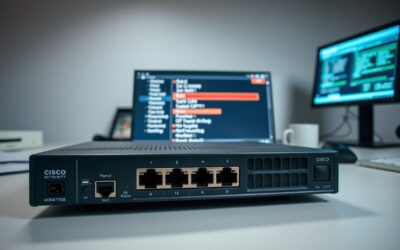Ever felt overwhelmed trying to protect your network from evolving threats? You’re not alone. A recent Cisco report found that 37% of IT professionals struggle with outdated tools when defending against attacks like rogue access points or social engineering. But here’s the good news: mastering core principles turns chaos into clarity.
Last week, over coffee, a colleague shared how Cisco’s unified segmentation approach saved their team from a near-disaster. “It’s not about chasing every new tool,” they said, “but understanding how access controls and data flow interact.” That’s the heart of network protection—building systems that adapt as threats evolve.
This guide cuts through the noise. You’ll learn practical strategies like configuring AAA frameworks and leveraging Layer-2 security tools—skills that directly apply to 15% of the CCNA exam content. We’ll blend real-world examples with emerging trends, giving you the confidence to tackle vulnerabilities head-on.
Key Takeaways
- Core security frameworks like AAA are non-negotiable for network reliability
- Layer-2 threats (ARP poisoning, DHCP spoofing) demand proactive monitoring
- Wireless protections evolve rapidly—WPA3 is now the baseline
- Access Control Lists shape traffic flow like digital traffic cops
- Real-world breaches often exploit overlooked configuration gaps
Understanding the Landscape of Network Security Challenges
Did you know 74% of breaches start with human error or system gaps? Hackers now target everything from smart thermostats to industrial sensors. Your coffee shop’s Wi-Fi router could become a backdoor to corporate data if left unpatched.
Recognizing Modern Cyber Threats
Phishing schemes tricked over 300,000 users last quarter alone, says McAfee. These attacks often exploit outdated software on personal devices. One hospital’s legacy MRI machine recently became a ransomware entry point—proving even medical systems aren’t safe.
Exploring Industry Research and Trends
Cloud-based attacks jumped 48% since remote work expanded. Attackers love unmonitored IoT gadgets: that “smart” office printer? It could leak sensitive information if access controls fail. New Dragos research shows 68% of industrial networks have critical vulnerabilities.
Zero-day exploits now target networking hardware directly. A recent DDoS attack crippled a major retailer’s payment systems for days. But here’s the kicker: 93% of these incidents could’ve been blocked with proper device configurations.
Your next move? Learn how layered defenses and real-time monitoring turn vulnerabilities into strengths. Because tomorrow’s threats are already evolving—and your protection strategies should too.
Deep Dive into Security Concepts in Networking
What if every data packet could tell a story? Modern networks thrive on smart rules that filter friend from foe. Let’s unpack three game-changers that keep your systems breathing smoothly.
Gatekeepers of Data Flow
Next-gen firewalls act like bouncers with X-ray vision. They don’t just check IP addresses—they inspect application behavior and block suspicious patterns. Cisco’s latest models even spot malware hiding in encrypted traffic. Here’s how they stack up:
| Firewall Type | Key Feature | Best For |
|---|---|---|
| Packet Filtering | Basic port/IP checks | Low-risk networks |
| Stateful Inspection | Tracks connection states | Mid-sized businesses |
| Next-Generation | Deep packet analysis | High-security environments |
CCNA’s Battle-Tested Approach
Ever troubleshoot a simulated ransomware attack? CCNA labs throw you into real crises. You’ll configure SSH access controls while defending against spoofed ARP requests. These drills teach you to:
- Spot abnormal traffic patterns
- Apply layered authentication methods
- Isolate compromised devices swiftly
Locking Data in Motion
Encryption turns sensitive info into digital scrambled eggs. Pair it with strict access rules, and you’ve got a powerhouse combo. Imagine hospital records: even if malware breaches the perimeter, AES-256 encryption keeps patient data unreadable.
Your coffee shop’s Wi-Fi? WPA3 now encrypts each user’s session separately. That’s progress—because yesterday’s “secure enough” often becomes tomorrow’s vulnerability.
Implementing Proven Practices for Network Protection
Think of your network as a digital castle—every layer of defense matters. Start by locking entry points with multi-factor authentication (MFA). This isn’t just about passwords anymore. Pair something you know (like a PIN) with something you have (like a mobile app) to block 99.9% of account breaches, according to Microsoft research.

Smart Verification for Modern Risks
Here’s how to roll out MFA effectively:
- Use tools like Duo Mobile to verify both user identity and device health
- Set conditional access rules for cloud applications
- Block outdated devices from accessing sensitive content
Next-Level Shields Against Intrusions
Next-gen firewalls work like AI-powered sentries. Unlike traditional barriers, they analyze traffic patterns and spot hidden threats. Fortinet’s models, for example, catch malware disguised as routine updates. Pair them with intrusion detection systems (IDS) for 24/7 monitoring:
| Tool | Strength | Best Fit |
|---|---|---|
| NGFW | Blocks zero-day attacks | Hybrid cloud setups |
| IDS | Flags suspicious behavior | High-risk industries |
| CASB | Secures SaaS apps | Remote teams |
Phishing emails? Ransomware? These tools create overlapping shields—like a castle’s moat, walls, and archers. Update rules quarterly, test defenses with simulated attacks, and watch your fortress stand strong. Because in the cloud era, stagnant protections become liabilities overnight.
Practical Security Solutions for CCNA Professionals
Imagine your network as a busy highway—smart traffic controls keep data flowing safely. Managed firewall services act like roundabouts, directing web application traffic while blocking malicious payloads. Cisco’s cloud-based tools recently helped a retail chain reduce breach response time by 83%—proof that modern solutions deliver real results.

Start by mapping internet-facing assets using centralized dashboards. A hospital IT team saved 20 weekly hours by automating firewall policy updates through Fortinet’s Fabric ecosystem. Prioritize these three steps:
- Deploy web-based monitoring to track system resources in real time
- Integrate multi-cloud security services with single sign-on capabilities
- Schedule monthly simulations to test backup computer system recovery
Balance protection and productivity with smart resource allocation. A school district blocked ransomware by filtering internet traffic through Cisco Umbrella while maintaining Zoom access for remote classes. Their secret? Granular controls that adapt to user roles.
| Solution | Key Benefit | Use Case |
|---|---|---|
| Cisco Secure Firewall | Unified cloud/on-prem rules | Hybrid workforces |
| FortiGate VM | Auto-scaling protection | E-commerce platforms |
| AWS Network Firewall | Deep packet inspection | API-driven systems |
Optimizing resources means knowing what to automate. One MSP uses AI-driven alerts to flag abnormal computer-controlled HVAC accesses—stopping lateral moves before they spread. As web security trends evolve, these practical frameworks keep your critical services running smoothly while preparing for tomorrow’s challenges.
Navigating the Latest Trends and Tools in Network Security
What separates proactive defenders from reactive responders? The answer lies in AI-driven solutions that spot threats before they strike. Darktrace’s research shows machine learning cuts intrusion response times by 73%—turning guesswork into precise action.
Leveraging AI and Machine Learning for Threat Intelligence
Imagine algorithms that learn your network’s heartbeat. Tools like Cisco SecureX analyze 250M+ daily events to flag anomalies. A bank recently thwarted a ransomware attack when AI noticed odd file access patterns on employee endpoints. Here’s why it works:
- Predicts zero-day exploits using behavioral analysis
- Automates privacy protection for sensitive files
- Scales across cloud and on-prem hardware
Advancing with Managed Services and SOC Insights
Overwhelmed teams are turning to SOC-as-a-Service. Arctic Wolf’s 24/7 monitoring helped a hospital block 18 intrusion attempts last quarter. Their secret? Three layers of modern defense:
| Tool | Impact | Example |
|---|---|---|
| XDR Platforms | Unify endpoint/cloud alerts | Microsoft Sentinel |
| Automated Playbooks | Resolve 40% of incidents instantly | Palo Alto Cortex |
| Policy Audits | Close 92% of configuration gaps | Rapid7 InsightVM |
Your move? Pair smart hardware upgrades with strict data policies. One retailer avoided a breach by encrypting files at the endpoint and adopting Zero Trust. Because in today’s landscape, management isn’t just maintenance—it’s survival.
Enhancing Your Network Security Through Continuous Learning
How do top defenders stay ahead of cybercriminals? They treat knowledge like armor—constually reforging it through real-world practice. A CompTIA study found teams that prioritize ongoing training reduce breach risks by 40%. Let’s unpack how you can build this mindset.
Take Maria, a sysadmin who earned her CISSP last year. During a phishing drill, she spotted suspicious email headers others missed—skills honed in Hack The Box labs. Her quick action saved her company from a simulated ransomware attack. Stories like hers prove certifications aren’t just resume boosters—they’re survival tools.
Building Expertise Through Data-Driven Habits
Effective learning blends theory with hands-on experiments. One hospital IT team slashed vulnerabilities by 55% after analyzing breach patterns in their network logs. They then replicated these scenarios in Cisco’s Packet Tracer to test responses. Try these tactics:
- Join Reddit’s r/netsec communities to dissect live attack reports
- Run weekly capture-the-flag exercises using TryHackMe
- Compare firewall configurations against NIST’s benchmarks
Tools like Wireshark and Splunk turn abstract concepts into tangible skills. A recent AWS lab let engineers trace data leaks across hybrid clouds—revealing misconfigured S3 buckets. These experiences make textbook principles click.
Your next move? Start small. Dedicate 30 minutes daily to Cybrary courses or local DEF CON meetups. Track progress with a learning journal. Because in this field, standing still is the fastest way to fall behind.
Conclusion
Your network’s resilience hinges on blending technical safeguards with perpetual learning. Like updating a map for uncharted terrain, regular configuration reviews and threat intelligence feeds keep defenses sharp. A recent hospital breach was thwarted by combining Cisco’s real-time alerts with quarterly access policy audits—proof that layered strategies work.
Prioritize tools that grow with your needs. Fortinet’s AI-driven platforms, for instance, automatically adjust firewall rules based on emerging attack patterns. Pair these with hands-on labs to test responses to simulated cloud-based intrusions. Three essentials to act on now:
1. Schedule biweekly checks for device firmware updates
2. Integrate Zero Trust principles into application access protocols
3. Bookmark Cisco’s threat advisory hub for trend analysis
Remember: Static setups crumble. That retail chain surviving a DDoS attack? They rotated encryption keys monthly and trained staff using breach simulations. Your turn—experiment with new authentication methods, share findings with IT communities, and let data guide your next upgrade. Start today by auditing one legacy system. Tomorrow’s threats won’t wait.
FAQ
Why is understanding access control critical for network protection?
How do next-generation firewalls differ from traditional ones?
Can encryption alone secure a network from cyberattacks?
What role does AI play in modern threat intelligence?
How does CCNA training prepare you for real-world attacks?
Why are managed security services gaining popularity?
What’s the biggest mistake companies make with user authentication?
Source Links
- CCNA Training » Key Security Concepts Tutorial
- cisco Ccna-Security Fundamentals: Security Concepts
- CCNA certification prep: Security fundamentals
- What is Network Security | Threats, Best Practices | Imperva
- How to Navigate Network Security in a Rapidly Evolving OT Cyber Threat Landscape | Dragos
- Top 6 Solutions for Managing Network Security Challenges
- A deep dive into network security protocols
- Network Protection: How to Secure a Network in 13 Steps
- 14 Network Security Tools and Techniques to Know
- CCNA Security : From Basic Networking To Security Expertise – ITU Online IT Training
- Cisco CCNA Security: A Deep Dive Into Network Security Expertise – MyComputerCareer
- What Is Network Security?
- What Is Network Security? Definition and Types | Fortinet
- Navigating 2024: Transformative Trends Shaping the Tech Landscape
- What are the Emerging Trends and Top Use Cases for Network Detection and Response?
- Here’s how you can showcase your dedication to continuous learning in network security.
- Here’s how you can enhance your skills through a network security continuing education program.
- Network Security Basics- Definition, Threats, and Solutions
- Introduction to Security in Computing, 5th Edition
- 6 Network Security Protocols You Should Know
- Key Security Concepts to Learn for a Career in Cybersecurity





